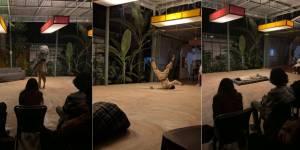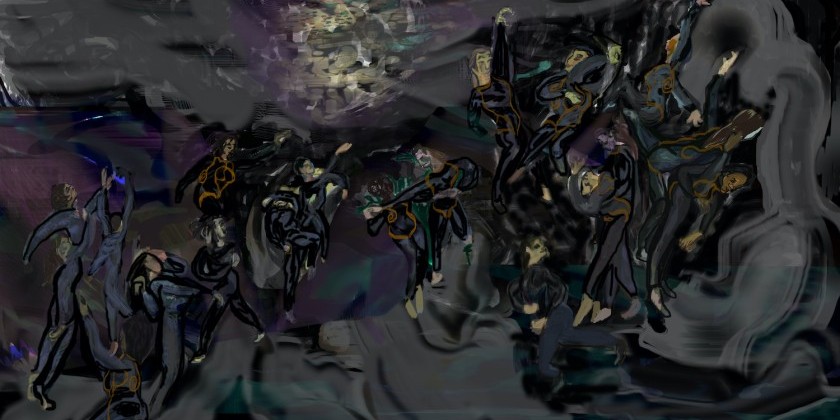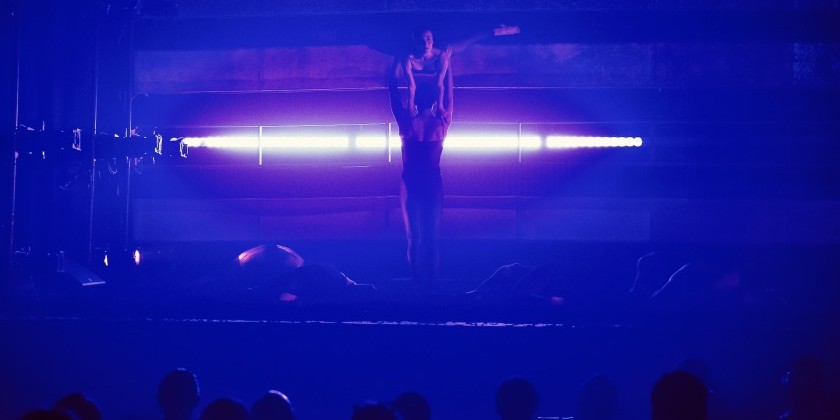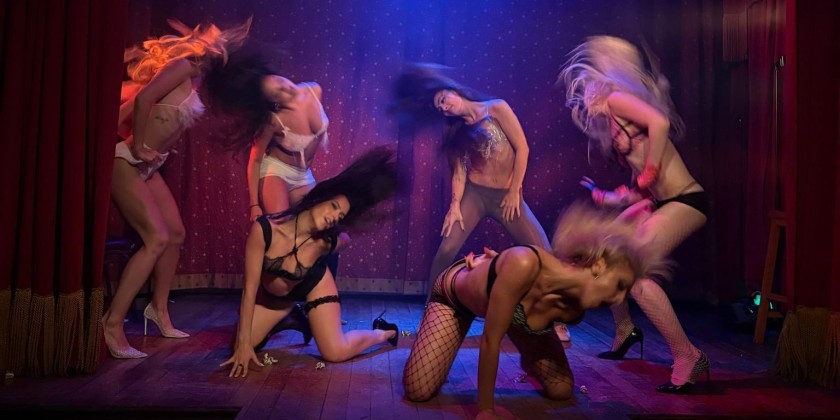AUDIENCE REVIEW: Wild Beast Dance Premieres in Rochester Fringe Festival
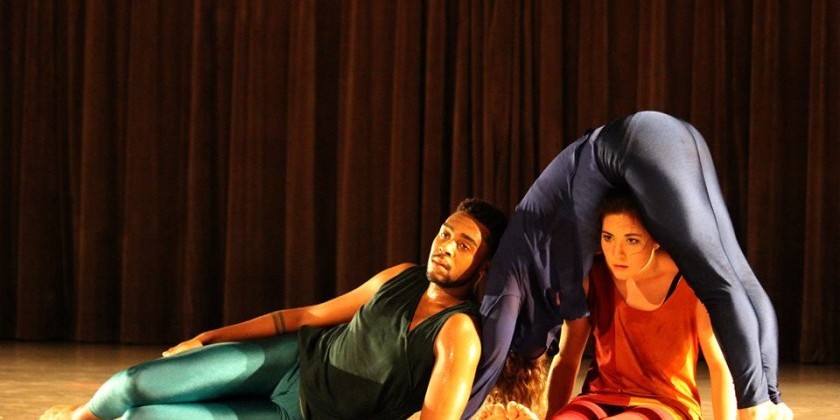
Company:
Wild Beast Dance (Artistic Director: Tammy Carrasco)
Performance Date:
Tuesday September 20th and Saturday September 24th
Freeform Review:
Wild Beast Dance Premieres in Rochester Fringe Festival
Wild Beast Dance premiered its first full-length show this past Tuesday, September 20th at MuCCC Theater in Rochester, NY as part of the city’s Fringe Festival. Magnified by the intimacy of the venue, Wild Beast Dance tangibly cultured a variety of virtuosic realities. The hour-long program consisted of four varying, yet articulately connected pieces.
The company’s Artistic Director Tammy Sugden-Carrasco is a Professor of Dance at SUNY Brockport, allowing Wild Beast Dance to find a home on campus as well as within the Rochester public. Assumed by the company’s name, Sugden-Carrasco and her dancers have ferocity in their aware bodies. Passionate connectivity morphs their trained bodies into characters that are not only otherworldly but also transparently human.
As a small-statured, compact woman, Sugden-Carrasco is artistically pushed by her company’s name as a title to constantly “live up to,” she said. However, the naming of Wild Beast Dance sourced from a more historic sensibility.
Connected to her thesis work at The Ohio State University, Sugden-Carrasco studied the twentieth-century group of French Artists encapsulating the Fauvism movement. Named Les Fauves, translating to “Wild Beasts,” these philosophical artists played with how to represent an image a viewer can see and recognize. In this mindset, what was seen on the canvas was the main subject at hand. That was where the meaning birthed and grew, making absurd reality purely real because that was what the eye was viewing live.
The “movement is the meaning,” Sugden-Carrasco said while discussing the root of her company’s name. Fauvism artists would play with images known daily to the human eye and alter them. Each transformation declared its own emotional state through color, light, and texture without needing to be true to “natural” and societal accuracy. Allowing these radical notions to mix with the vulnerability of being human has importance to Sugden-Carrasco: “the Wild Beast artists would allow the paint to bubble, to texturize,” which is a product of art making her choreography emphasizes. She allowed the audience to see the humanity of her performer’s within the constantly transitioning, elemental reality she painted within MuCCC this week.
The perception of individuals in her raw worlds was introduced right away with the first piece of the night, Straight Jacket danced by Sugden-Carrasco and SUNY Brockport Professor of Dance, Stephanie Oakes. The opening lights lifted the viewers into a scene of two uniformly dressed women. They were clad in tan sleeveless turtleneck tops, each decorated with a bold black zipper vertically sewn on the torso. Black high-wasted pants and golden sneakers dressed their lower bodies. Their physiques also mirrored this uniformity. Short curly hair, small figures, and a clearly defined slump of their cervical spines unfolded the dance as somberly slow rotations on top of a large black platform gave a topographical dynamic to the stage. These rotations around themselves gradually gave way to gestural bursts of motion, grabbing and outlining their spatial parameters.
Straight Jacket had a consistency of elastic pulls, as the dancers would pause into unison and then energetically leap their bodies off the platform, back onto the platform, and into heart racing partnering that tested how the duet could become a trio of pressure with the prop. They scaled the edges of the platform, slammed their bodies onto its surface, and relinquished its importance through equally sculpted movement material within the rest of the stage. The music composition (consisting of pieces by Nadia Sirota, Dan Panner, Mike Wall, Adam Crawley and Jon Scoville) disappeared and spliced back in throughout the timeline of the dance. The two playfully satisfying movers rode these musical waves, catching up and breaking down into individual phrases of serious, strongly defined quirks that deluded the line between gestural and virtuosic. This delusion molded the individual dancer’s relationship of tender ignorance towards the needs of the other body: to let the other fall, leave, or come back into spatial intimacy.
As the dance came to a close, Oakes and Sugden-Carrasco breathed within their square world on top of the platform. With a reaching leg of Oakes’s lengthening up and supported by Sugden-Carrasco’s counterbalanced body, the lights drifted down and the music left the theater.
The following quartet colorfully changed the atmosphere for eyes and ears alike. Are You My Mother? was both vocally and physically performed by Jordan Lloyd, Nicole Woodcock, Heather Roffe, and Marissa Aucoin. Noises sprang into earbuds as the four movers vocally initiated shifting feet, crouching motions, and socially strange behavior that built a wonderland of curiosity. Dressed in varying patterns, color schemes, and hairstyles, the bodies in space complimented the cohesive confusion of the noises. Comically serious performance faces and jumpy full-body motions of the dance supported this perspective.
The vocal support to the physical vocabulary was a large map, cut into pieces, and whimsically puzzled back together for choreographic satisfaction. The outline was clear, vibrant, and smooth but the mysterious awe swam within their world and left the audience reaching for inclusion into the hypnotic habitat visiting the stage. Viewers were mystified into a hallucinogenic surrender. The ability of the four dancers to confidently believe in the unarguable commitment between the movements and the vocals was captivating.
“I knew it would be difficult, but what made it easier was finding movement that allowed for the sound to naturally evolve. The sound and the movement in that sense became one, making the sound as important as the movement in the body,” said dancer Jordan Lloyd.
Sugden-Carrasco’s choreographic processes usually spark by watching the movements of her dancers in the studio. She then highlights how they move through how she makes. Dedication to this structural process inevitably allowed a charmingly quirky dance to take charge of the theater and recharge the imagination and comprehensive-boundaries of the audience members.
Third on the stage was Lucida, a solo danced by SUNY Brockport BFA Sophomore Joyce Edwards. “I asked her to not ignore herself in the process,” said Sugden-Carrasco. This coaching allowed the individuality of the precise Edwards to become embedded in this velvety rich dance. Vibrant costuming brought a stoic sensuality to her far-reaching motions, as Edwards sequenced through her long limbs in a draping red tunic and pants. Musically accompanied by Heitor Villa-Lobos, Lucida teased with all levels of the space. A pose that glided to the floor, with Edwards’s back facing away, gave a picturesque profile that breathed between her voluminous skimming jumps, circular dips, and vulnerable gestures. She fluidly bounced the dance from proximal to distal reaches. Making space for an extremely sophisticated performer, Sugden-Carrasco innately tailored this piece to the motion-favorings of Edwards. The atmosphere of the room was sensually swirled into a transfixion on Edwards’s long-limbed residue as her mature dancing came to a boldly simmering end.
The closing colors of Wild Beast Dance’s show were executed by the company’s namesake: a trio entitled Les Fauves (The Wild Beasts). The translating bodies of this dance were already familiar: Jordan Lloyd, Stephanie Oakes, and Nicole Woodcock. As the company name was sourced from research within her graduate degree, so was this piece. It had its first life within OSU in Sugden-Carrasco’s thesis project. The dance ranged from a set repertory vocabulary to a string of improvisational scores. Satisfying to the choreographer, as she reset and re-cultured this piece on a new cast, these improvisations cultivated the same branch of movement qualities and environments as it did within her thesis performance research. A loyalty to this piece was not only active within Sugden-Carrasco’s perspective, but also vibrantly living within the historical body of the work.
“We learned the dance in sections, referring to each as a world… The dance became a practice of jumping from world to world,” Jordan Lloyd explained. This emphasis was clearly patterned in the dance, as it was unknown where the performers would qualitatively spring to next. Questions excitedly swirled through the air: What world would their emotions collide with? Who was going to transform? Where would they transition to?
Music (ranging from Meredith Monk to Prince) stylistically shifted equally as much as the multiplying personalities of the dancers. The glimmering color choices of the costumes hugged this transforming reality of the piece. They glowed in an abstract sense of a uniform, highlighted by Lloyd’s greens, Oakes’s blues, and Woodcock’s orangey reds.
The fourth wall was kicked down by the unapologetic stares and facial expressions of the creatures on stage as they partnered, soloed, indulged in unison, and breathed through the absurd. And the audience was with them. Sugden-Carrasco not only introduced the weird. She individually defined it through her dancers’ notions of what each section of the dance felt like, smelled of, and was made with.
Wild Beast Dance altered perceptions of what true nature is, how it may mold, and how it could complicate depending on the hour, the environment, and the witnessed image. Satisfying both intellectually and visually, Sugden-Carrasco created a stimulating evening that gifted fulfilling questions about what is next for this powerful company.
(Photo by Cassie Burns)




